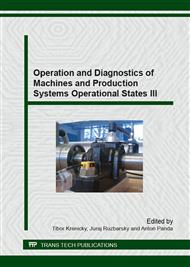[1]
H.A. Youssef, H. El-Hofy, Machining Technology: Machine Tools and Operations, CRC Press, (2008).
DOI: 10.1201/9781420043402
Google Scholar
[2]
A. Panda et al., Accompanying phenomena in the cutting zone machinability during turning of stainless steels, International Journal of Machining and Machinability of Materials 5/4 (2009) 383-400.
DOI: 10.1504/ijmmm.2009.026899
Google Scholar
[3]
E. Isakov, Cutting Data for turning of steel, Industrial Press, New York, (2009).
Google Scholar
[4]
E.D. Whitney, Ceramic Cutting Tools, William Andrew Publishing/Noyes, (1994).
Google Scholar
[5]
H. Tschätsch, Applied Machining Technology, Vieweg, Wiesbaden, (2007).
Google Scholar
[6]
J. Duplák, T-vc dependence for cutting ceramic in standard ISO 3685, Manufacturing Engineering 9/4 (2010) 58-62.
Google Scholar
[7]
J. Duplák, Verification of T-vc dependence for standard ISO 3685, in: Progressive technologies of machining: Papers of center of progressive technologies 2010, Prešov, FVT TU, pp.45-52.
Google Scholar
[8]
J. Duplák, M. Hatala et. al, T-Vc Dependence for sintered metal in standard ISO 3685, Technological Engineering 7/2 (2010) 6-9.
Google Scholar
[9]
J.R. Davis, Materials: ASM Specialty Handbook, ASM International, Ohio, (1998).
Google Scholar
[10]
J. Mihok, J. Markovič, Importance of planning as a core function of strategic management, Management of Companies (Manažment podnikov) 3/2 (2013) 57-58.
Google Scholar
[11]
J. Zajac et al, Cutting facilities of new type of came cutting material, in: Proceedings of the Conference PPTO, Košice, 1995, pp.138-139.
Google Scholar
[12]
K. Vasilko, Analytical theory of splinter machining, FMT TUKE, Prešov, (2007).
Google Scholar
[13]
R. Cep et al, Surface roughness after machining and influence of feed rate on process, Key Engineering Materials 581 (2014) 341-347.
Google Scholar
[14]
M. Zelenak et al, Comparison of mechanical properties of surface layers with use of nanoindentation and microindentation tests, Metalurgija 51/3 (2012) 309-312.
Google Scholar
[15]
M. Zelenak, J. Valicek, J. Brumek, P. Hlavacek, B. Haluzikova, M. Vylezik, P. Babkova, M. Harnicarova, V. Szarkova, M. Kusnerova, V. Kubena: Measurement and analysis of the hardnees of aluminium surface layers by the nanoindentation and scratch tests. 2011, Chemické Listy 105, 688-691.
Google Scholar
[16]
Standard STN ISO 3685: Tool-life testing with single-point turning tools, (1999).
Google Scholar
[17]
T. Krenický, Non-contact Study of Surfaces Created Using the AWJ Technology, Manufacturing Technology 15/1 (2015) 61-64.
DOI: 10.21062/ujep/x.2015/a/1213-2489/mt/15/1/61
Google Scholar
[18]
T. Duraník, J. Ružbarský, M. Stopper, Influence on the Productivity of Modern Thermoset Preheating in the Compression Molding Technology, Advanced Materials Research 717 (2013) 74-78.
DOI: 10.4028/www.scientific.net/amr.717.74
Google Scholar
[19]
T. Zaborowski, Eco-production (Ekowytwarzanie), IBEN, Gorzów Wlkp, 2007 (in Polish).
Google Scholar


